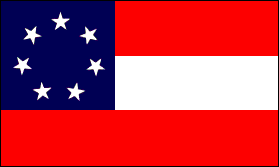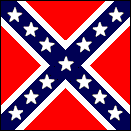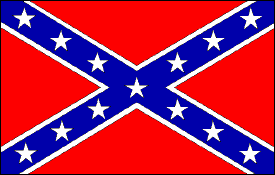The First Official Flag of the Confederacy.
|
|
|
| Although less well known than the "Confederate Battle Flags", the Stars and Bars was used as the official flag of the Confederacy from March 1861 to May of 1863. |  The pattern and colors of this flag did not distinguish it sharply fom the Stars and Stripes of the Union. Consequently, considerable confusion was caused on the battlefield. The seven stars represent the original Confederate States;
|
| On May 1st,1863, a second design was adopted, placing the Battle Flag (also known as the "Southern Cross") as the canton on a white field. This flag was easily mistaken for a white flag of surrender especially when the air was calm and the flag hung limply. |  |
| Efforts to secede failed in Kentucky and Missouri though those states were represented by two of the stars. *(see note below) The flag now had 13 stars having been joined officially by four more states, |
| The third Official Flag of the Confederacy. On March 4th,1865, a short time before the collapse of the Confederacy, a third pattern was adapted; a broad bar of red was placed on the fly end of the white field. |  |
| The best-known Confederate flag was the Battle Flag, the familiar "Southern Cross". It was carried by Confederate troops in the field which were the vast majority of forces under the confederacy. The Stars represented the 11 states actually in the Confederacy plus Kentucky and Missouri. |
 |
| Used as a navy jack at sea from 1863 onward. This flag has become the generally recognized symbol of the South. |  |
| The first recorded use of the lone star flag dates to 1810. On September 11, 1810 a troop of West Florida dragoons set out for the provincial capitol at Baton Rouge under this flag. They were joined by other republican forces and captured Baton Rouge, imprisoned the Governor and on September 23, 1810 raised their Bonnie Blue flag over the Fort of Baton Rouge. Three days later the president of the West Florida Convention, signed a Declaration of Independence and the flag became the emblem of a new republic. By December 10, the flag of the United States replaced the Bonnie Blue after President Madison issued a proclamation declaring West Florida under the jurisdiction of the Governor of the Louisiana Territory. With this rebellion in mind, this flag was used by the Republic of Texas from 1836 to 1839. On January 9, 1861 the convention of the People of Mississippi adopted an Ordinance of Secession. With this announcement the Bonnie Blue flag was raised over the capitol building in Jackson. Harry Macarthy was so inspired that he wrote a song entitled "The Bonnie Blue Flag" which became the second most popular patriotic song of the Confederacy. The Confederate government did not adopt this flag but the people did and the lone star flags were adopted in some form in five of the southern States that adopted new flags in 1861. |  Bonnie Blue |
* Both MO and KT had representatives in the CSA and USA national legislatures. They both had designated units in the national armies. Both the CSA and USA national governments recognized them as part of their respective countries. The only reason the two states are considered only part of the USA is that they were occupied by invaiding USA troops. Both MO and KT *were* a recognized part of the CSA.
Additional Reading
Civil War Exhibits
Civil War Picture Album
Civil War Submarines
State Battle Maps
Civil War Recipies
Music "Dixie" source http://home.att.net/~dmercado/music.htm